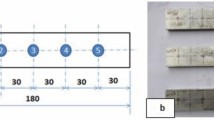Abstract
The traditional method of measuring the cleanliness level of steel is to measure its total oxygen (TO), which does not provide information about the size, location, and distribution of more harmful macroinclusions. The present article highlights a novel method for cleanliness assessment in steel samples using ultrasonic C-scan image analysis. The method provides quick and large volume inspection and ability to catch macroinclusions that possess difficulty during further processing of the thin gage steel products, particularly for auto grades such as interstitial-free (IF) steel. This method deals with a multiscan, immersion ultrasonic system using high-frequency focused beam and image analysis software. A good correlation was found between ultrasonic parameter counts and TO in steel samples taken from tundish during the continuous casting of slab. The ultrasonic counts were also found to be correlated with some steelmaking parameters.











Similar content being viewed by others
Notes
LECO is a trademark of LECO Corporation, St. Joseph, MI.
Abbreviations
- SNR:
-
signal-to-noise ratio
- H s, H n :
-
signal and noise amplitudes, respectively
- S a , S f :
-
probe and flaw/inclusion areas, respectively
- d :
-
distance of the flaw/inclusion from the probe
- w :
-
Wavelength of ultrasound
- τ :
-
pulse height
- δ s :
-
scatter coefficient, a function of wavelength of ultrasound and grain size of matrix material
- η :
-
directional pattern, a function of wavelength and crystal size of the probe
- f :
-
frequency of ultrasound
- V :
-
velocity of propagated sound wave
- f op :
-
optimum frequency
- d s :
-
diameter of spherical reflector
- R :
-
reflection coefficient of ultrasonic energy at the interface of two media
- Z 1 :
-
acoustic impedance of medium 1
- Z 2 :
-
acoustic impedance of medium 2
- D :
-
mean scatterer diameter
- α rs :
-
ultrasonic Rayleigh scattering losses
- α ss :
-
ultrasonic stochastic scattering losses
- α ds :
-
ultrasonic diffusion scattering losses
- K rs :
-
ultrasonic Rayleigh scattering constant
- K ss :
-
ultrasonic stochastic scattering constant
- K ds :
-
ultrasonic diffusion scattering constant
- S w :
-
water path
- S f :
-
focal distance in water
- S m :
-
sound path in test material
- C w :
-
sound velocity in water
- C m :
-
sound velocity in test material
- v :
-
upward velocity due to density differences between steel and inclusion
- g :
-
gravitational acceleration
- μ Fe :
-
dynamic viscosity of steel
- ρ Fe :
-
density of inclusion
- r :
-
radius of the floating particle (inclusion)
- RH:
-
Ruhrstahl Heraeus
- SEM:
-
scanning electron microscopy
- EDS:
-
energy-dispersive spectroscopy
- TO:
-
total oxygen
- MIDAS:
-
Mannesmann inclusion detection by analysis of surfboards
- LSHR:
-
liquid sampling hot rolling
References
C. Bonila: Steelmaking Conf. Proc., ISS, Warrendale PA, 1995, vol. 78, p. 743
L. Zhang, B.G. Thomas, X. Wang, and K. Cai: Steelmaking Conf. Proc., ISS, Warrendale PA, 2002, vol. 85, pp. 431–52
T.K. Roy, J.C. Pandey, S. Banerjee, P. Srinivas, S. Dhar, and T. Venugopalan: Tata Search, 2008, vol. 2, pp. 335–39
H. Jacobi and K. Wunnenberg: Ironmaking and Steelmaking, 2003, vol. 30, pp. 130–41
T. Sjökvist, M. Göransson, P. Jönsson, and P. Cowx: Ironmaking and Steelmaking, 2003, vol. 30, pp. 73–80
J.C. Pandey and M. Raj: Ironmaking and Steelmaking, 2007, vol. 34, pp. 482–90
I.N. Eromolov and B.P. Pilim: NDT Int., 1976, vol. 9, pp. 275–80
ASNT Handbook, vol. 7, Ultrasonic Testing, American Society for Nondestructive Testing Inc., Columbus, OH, pp. 390–91
M. Darmon, P. Calmon, and B. Bèle: Ultrasonics, 2004, vol. 42, pp. 237–41
ASNT Handbook, vol. 7, Ultrasonic Testing, American Society for Nondestructive Testing Inc., Columbus, OH, 1991, p. 262
V.H. Tapia, R.D. Morales, J. Camacho, and G. Lugo: 79th Steelmaking Conf. Proc., ISS, Warrendale, PA, 1996, vol. 79, pp. 539–47
Y. Miki and B.G. Thomas: Metall. Mater. Trans. B, 1999, vol. 30B, pp. 639–54
K.W. Lange: Int. Mater. Rev., 1988, vol. 33, pp. 53–89
Acknowledgments
The authors are thankful to the management of Tata Steel for giving permission to publish this work. Thanks are also due to Mr. Shekhar Banerjee, Dr. P. Srinivas, and Mr. Sanjay Dhar for their help in getting samples and analysis work.
Author information
Authors and Affiliations
Corresponding author
Additional information
Manuscript submitted November 14, 2007.
Rights and permissions
About this article
Cite this article
Pandey, J., Raj, M., Roy, T. et al. A Novel Method to Measure Cleanliness in Steel Using Ultrasonic C-Scan Image Analysis. Metall Mater Trans B 39, 439–446 (2008). https://doi.org/10.1007/s11663-008-9146-6
Published:
Issue Date:
DOI: https://doi.org/10.1007/s11663-008-9146-6




